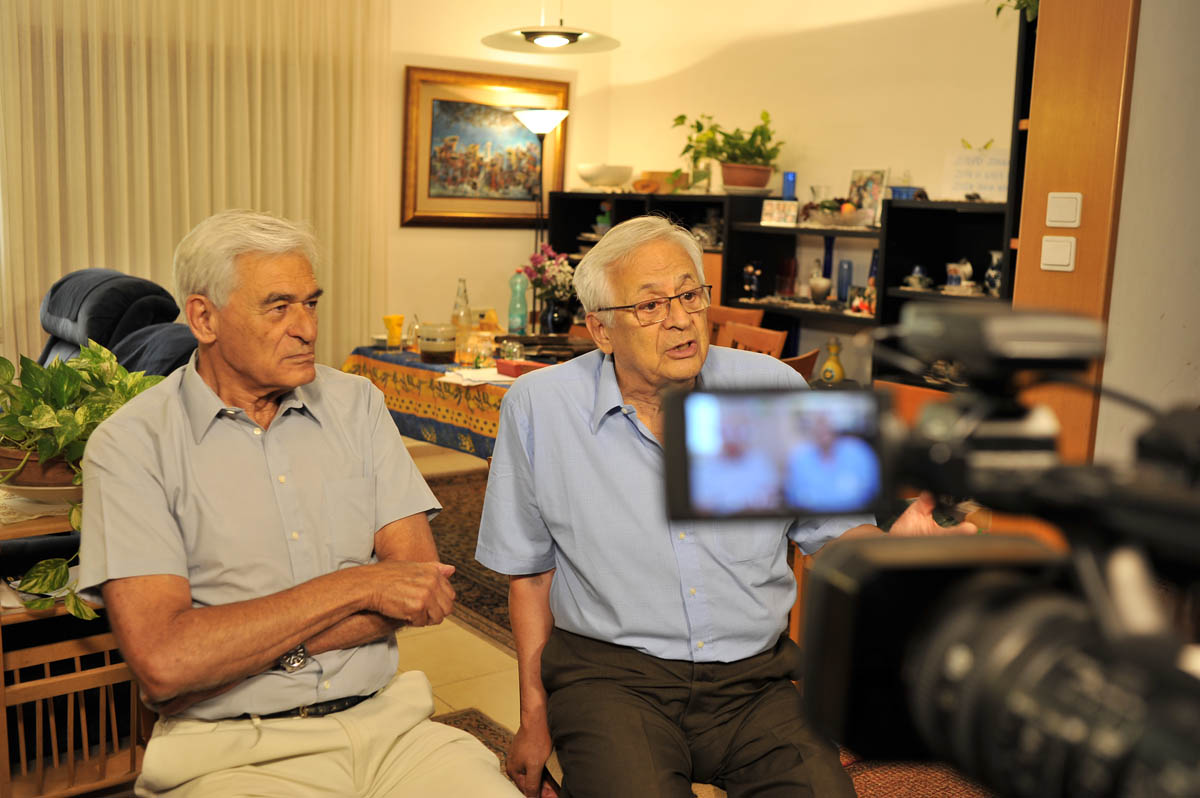
Brothers Eli (left) and Dan Steiner, Holocaust survivors from Zagreb, Yugoslavia (today Croatia), being interviewed by Nava Gibori and filmed by Yifat Barkan in Dan's home in Haifa, Israel, August 2017
“For many years, I ignored anything that had to do with the Holocaust, even though I’m a Holocaust survivor. As I grew older, and especially in recent decades, I felt the need to document what I experienced… During the interview, they made me feel as if I were the only person on earth, and they gave their undivided attention and energy to me and me alone. They were very polite, and it was evident that they had prepared well for the interview. They knew the right questions to ask, the right time to ask them, and how to conduct the interview appropriately and calmly. It was a pleasure to have their company.”
So recalled Holocaust survivor Israel Shaked after Merav Shani of Yad Vashem's Testimonies Section interviewed him in May 2017, together with cameraman Ran Adam.
Over the past decade, Yad Vashem has been expediting its work to record the testimony of survivors in Israel by offering to come to their homes. “As the years go by, we’ve witnessed a change in the importance for Holocaust survivors to give testimony,” said Yad Vashem Archives Director Dr. Haim Gertner. “If to date many of them dealt with the trauma in silence, nowadays the younger generation’s wish to learn more and share their families' histories on social media encourages survivors to speak up. The general public isn’t always aware that Yad Vashem has skilled and professional teams who record testimony from survivors, and that’s one of our missions in the near future: raising the public’s awareness, and recording more testimony from Holocaust survivors.”
The challenge of recording testimony has become even more complicated, and not only because of the emotional complexity involved. The majority of survivors still alive today survived the Holocaust at a young age, having been born in the 1930s or even the early 1940s. They tell what they know about their lives during the Holocaust, sometimes based on fragments of memories that coalesce with information they heard and that their acquaintances passed on to them. The interviewer’s job is to find the ways to spur personal memories, to turn the fragments of memories into concrete information.
“These people were babies or infants during the war,” explains Sigal Holzmann, who has been conducting interviews for 17 years. "Some of them barely know anything about their past, or have fragments of information and memories. Some of them never felt they were Holocaust survivors, and preferred to stay away from the topic their whole lives, right up to the time of the interview. However, with the aid of the relevant historical knowledge, together we try to build a coherent and sequential story. It’s a very emotional process, and there’s not a dry eye in the house when it’s over.”
Someone else is present during the testimony, but goes unnoticed, although their job is very significant. Quietly and professionally, the cameramen of the Testimonies Section turn the survivors’ homes into film studios. They set up the room and angle the lights to create a clear area with no distractions. “There’s no curtain to separate the cameraman from the survivor when you’re filming in their home,” explains Filming Coordinator Mickey Zilberstein. “The cameraman sits behind the interviewer, across from the survivor, and makes unbroken eye contact. This requires heightened alertness from the cameraman and ensures that he pays attention to the testimony… There were many times when I cried behind the camera. I go on the journey with the survivors; I go through the process through the lens with each and every one of them, and dive hand-in-hand into their memories.”
Immediately after recording the testimony, the cameramen produce a copy for the survivors and their families. In many cases, members of the younger generation watch the copy of the testimony right away, and poignantly thank the interviewer team. “Thank you so much for agreeing to my request to interview my mother, after so many years of her refusing to talk,” wrote Ariella Angel, daughter of Ita Heide, to interviewer Ronit Wilder and cameraman Daniel Daniel.
“Every time we asked her, she insisted it wasn’t a ‘story’ and that nobody could understand what she went through. I decided not to give up and convince my mother to talk to you, because you’re the experts on the subject, and it's important to pass the history of her lost and cruel youth on to our grandson and her great-grandchildren, who long to hear it all.”
The Yad Vashem Archives contain over 129,000 testimonies in video, audio and written formats. Yad Vashem records over 1,000 video testimonies annually. To schedule a time to give testimony in Israel, please call 02-644-3888.
Yad Vashem's testimony collection efforts are supported by: Jack and Marilyn Pechter; Hudson Bay Capital; Vladimir Zemtsov, the Philip Chosky Trust; the Circle of Service Foundation; the Nash Family Foundation; Samson Charity Foundation, based in Switzerland; Friends of Yad Vashem in Austria; Society of Friends of Yad Vashem in Liechtenstein; Swiss Friends of Yad Vashem; and Hamburger Stiftung zur Förderung von Wissenschaft und Kultur.
First published in Yad Vashem Jerusalem magazine, #84, October 2017



